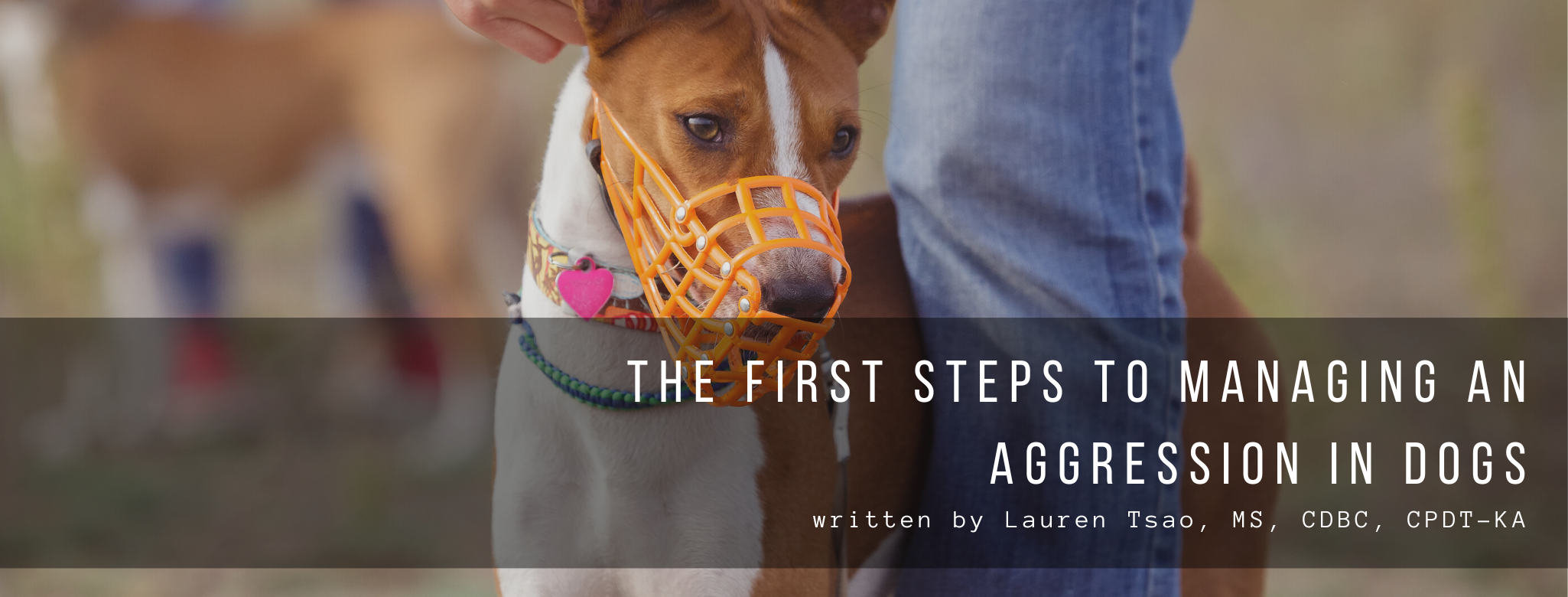The First Steps To Managing Aggression in Dogs
Written By Lauren Tsao, MS, CDBC, CPDT-KA
Anyone who has ever owned a dog knows that they are capable of exhibiting a wide range of emotions, from happiness and excitement to fear and aggression. Unfortunately, even the best-behaved dog may exhibit aggression under certain circumstances. If your dog is exhibiting aggressive behavior, it is important to take steps to manage the aggression in order to keep both your dog and those around him safe. The best-laid training plans start with the management of the dog’s undesirable behaviors to prevent further reinforcement. In this blog post, we'll discuss three strategies for managing aggressive behavior in dogs: using training equipment like muzzles, rearranging the environment for success, and preventing your dog from practicing undesirable behaviors.
First Line of Defense: Muzzles
One way to manage aggression in dogs is to use a muzzle. Muzzles can prevent dogs from biting or minimize damage from a bite, depending on the type of muzzle. If you use a muzzle, it is important to ensure that it fits properly and that your dog is comfortable wearing it. You also need to select the right type of muzzle for your situation.
Certain muzzles, like groomer’s muzzles, shouldn’t be left on dogs for an extended period of time because it inhibits the dog’s ability to pant. Basket muzzles, however, can be used for longer periods of time while your dog is supervised. Muzzles should never be left on your dog unattended, as they propose a safety risk if your dog’s muzzle gets caught on something. It is also important to keep in mind that not all muzzles are bite-proof so it is best to have a professional assist you in the correct muzzle selection for your dog.
You should also be aware that muzzles should not be used as a punishment; rather, they should only be used when necessary to prevent your dog from hurting others.
Rearranging the Environment for Success
Another way to manage aggression in dogs is to rearrange the environment so that your dog is less likely to feel agitated or threatened. For example, if you have a dog who is aggressive toward other dogs, you might want to consider keeping him on a leash when you are out for walks and avoiding areas where there are likely to be other dogs present. Some owners even opt to discontinue walking their dog entirely until their dog completes a behavior modification program with a certified professional dog behavior consultant or certified dog trainer experienced in training aggressive dogs.
Similarly, if your dog is fighting with other dogs in the household, you might want to install pet gates between the dogs and utilize a technique called “crate and rotate”, so only one dog has access to their area of the home at a time and the dogs are never alone together. If you have visitors over and your dog is aggressive towards strangers, put your dog in another room or crate him until they leave. By taking these precautions, you can prevent your dog from practicing aggressive behaviors.
Preventing Your Dog From Practicing Aggressive Behavior
Finally, it is important to prevent your dog from practicing aggression, by considering ways to decrease his access to triggers. Dogs can be affected by a concept called “trigger stacking”, which occurs when dogs are exposed to many stressors or “triggers” throughout the day. Maybe one of those stressors alone wouldn’t be enough for them to react, but after being exposed to many stressors over the course of the day, your dog might eventually react aggressively to a stressor that they can usually handle under normal circumstances. By considering how many stressors your dog is exposed to in a day and trying to minimize them, you can help prevent him from reaching his boiling point. Providing your dog with regular training and puppy socialization before your dog is showing any aggression will also help to prevent future problems by teaching him how to behave appropriately in different situations.
Dogs can exhibit a wide range of emotions, from happiness and excitement to fear and aggression. If your dog is exhibiting aggressive behavior, it is important to take steps to manage the aggression in order to keep both your dog and those around him safe. Being proactive in these situations is much better (and safer) than being reactive. Muzzles, environmental management, and prevention are all effective strategies for managing aggressive behavior in dogs.
If you think your dog may be exhibiting signs of aggression, contact a certified dog behavior consultant for assistance. You can contact me, a certified dog behavior consultant, directly here for help in the Jackson, MS metro area or virtually. By taking these steps, you can help keep both yourself and your furry friend safe and happy.

